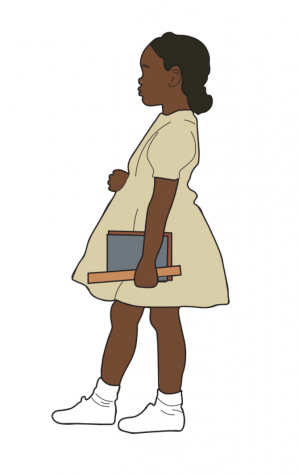Movies
November 9, 2020
“Ruby Bridges”

PG | 1998
Content warning
This movie contains racial slurs and scenes of threatened assault towards a child.
Summary
I initially thought this movie would follow the standard Black injustice plot. But the more I watched it, the more in awe of the main heroine I was.
It’s based on the true story of Ruby Bridges, who is Black. In 1960, when she was 6, she was chosen to attend an all-White elementary school in Louisiana because of her academic ability — but while desegregated schools were technically national law in 1960, Southern states were slow to mix races.
So when Ruby began attending the all-White school, she faced plenty of backlash.
Crowds of White people would gather around the school’s entrance every morning, chanting racial slurs and threats at her as she entered school. White parents pulled their children out of the school until Ruby was the only student left, taught by one teacher.
Despite everything, though, she never missed a day of school. And day by day, with support from God, her family and her community, Ruby made it through the school year.
We could all stand to learn some of Ruby’s positivity, as she endures so much opposition without ever becoming bitter. Actress Chaz Monet portrays Ruby’s innocence flawlessly, and her slow realization that people don’t like her because of her skin tone is heartbreaking. Lela Rochon plays Ruby’s mother, whose determination to give her daughter a better education than she had is at the center of the story. Tender moments are scattered throughout the movie, and I cried on multiple occasions.
What you’ll learn
The movie has strong Christian values, as Ruby’s mother encourages Ruby to follow Jesus’ example by praying for those who “persecute” her. So Ruby prays for the people who hurl threats at her every day before school, and she asks God for help. Ruby leans on Him and her parents for comfort and does her best to move with life.
“Ruby Bridges” also promotes the importance of helping people who are in need, and being humble enough to admit when you need it.
Even though it lacks subtlety in portraying its messages, “Ruby Bridges” has plenty of historical value and will make you smile at the end.
“To Kill a Mockingbird”
NR | 1962
Content warning
This movie contains racial slurs, physical assault towards children and descriptions of sexual assault.
Summary
Whether you annotated “To Kill a Mockingbird” for English class or read the Sparknotes, you might have skimmed through it without realizing that it’s a crucial look at race.
This 1962 adaptation of the book by Harper Lee is from the perspective of 6-year-old Scout Finch, a girl growing up in 1930s Alabama. One day word gets out that Tom Robinson, a Black man, has been accused of raping a White woman. Scout’s father Atticus, who’s a lawyer, agrees to defend him in court.
Atticus is convinced that Tom is innocent, and he sees it as his duty to defend an innocent man. Scout and her brother Jem watch as he refuses to let the violence and threats that emerge from their Southern town shake his decision.
Gregory Peck carries the movie, and he is perfectly casted as Atticus.
No, he is Atticus.
And Mary Badham is Scout, whose father-daughter bond with Atticus is the movie’s warm undertone. Though “To Kill a Mockingbird” is a black and white movie, it is timeless and will stay in your heart long after it’s over.
What you’ll learn
If integrity was a person, it would be Atticus Finch.
He defends Tom, not because it was particularly the popular thing to do, but the right one. And he continues to stick by him for that reason. Scout and Jem adore Atticus, and he cares more about setting a good example for them rather than avoiding conflict with the townspeople. Atticus may be one of the greatest cinematic examples of how to fight for justice.
The way Tom Robinson’s trial is handled by the townspeople shows how powerful racial prejudice can be: it even has the potential to outweigh truth.
“Loving”

PG-13 | 2016
Content warning
This movie contains racial slurs and mild language, drinking, and racially motivated violence.
Summary
“Tell the judge I love my wife.”
I wish that had always been enough for the Lovings.
“Loving” is set in the 1950s and follows newlyweds Richard and Mildred Loving, both of whom grew up in Virginia. Richard is White and Mildred is Black, and they want to raise their family together near Mildred’s childhood home.
But according to Virginian law, interracial marriage was unacceptable. Law enforcement gives the couple an ultimatum: spend time in jail, or leave the state together for 25 years. So after being expelled from their home state, the Lovings decide to fight to make their love legal.
With extraordinary acting and beautiful shots, “Loving” tells the true story of how the Lovings paved the way for the millions of American interracial couples today. There’s a gradual shift from the sweet “how I got the girl” romance between Richard and Mildred at the beginning of the movie to a strong and tested bond that can survive anything.
What you’ll learn
There’s plenty of educational value in “Loving,” as it gives viewers insight into the way race was viewed in segregated America. It’s heartbreaking to see how tension grows between Richard and Mildred as they become more and more aware of their marriage’s controversy, and it shows that other people’s expectations can strain a relationship. “Loving” examines how deep the divide between White and Black people can be, and how love can conquer it.